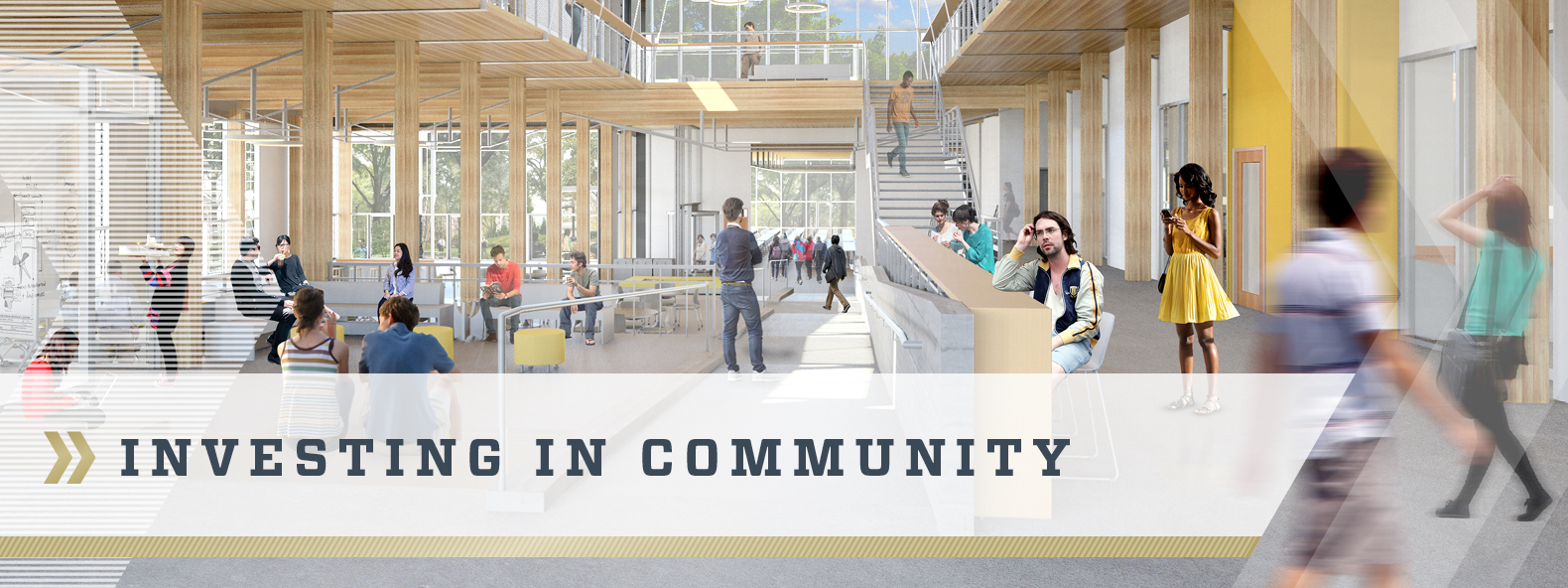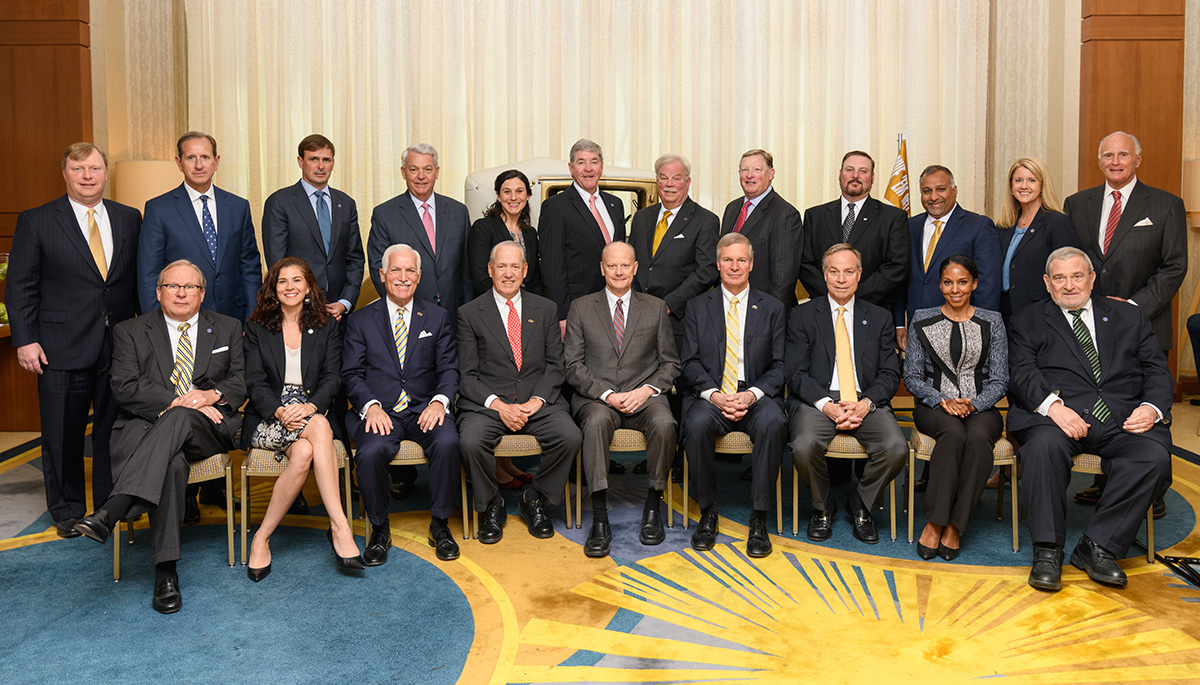
Annual Report 2018 Navigation
Annual Report 2018: Investing in Community
Supporting and strengthening communities — whether it’s the campus community or the Institute’s many external community partners — is a critical aspect of Georgia Tech’s mission and strategic priorities.
Construction Phase Begins for Kendeda Building

The northwest corner of Ferst Drive and State Street is beginning its transformation. Workers are establishing the building footprint by preparing for the concrete foundations (i.e. the footings) and the concrete walls of the building's basement level.
The Kendeda Building for Innovative Sustainable Design — under construction since fall 2017 in a former parking lot at the corner of Ferst Drive and State Street — is expected to become the most environmentally advanced education and research facility in the Southeast.
“Seeing the fencing go up and the grading equipment roll in was a major milestone,” said John DuConge, senior project manager for Facilities Management. “Given the very unique requirements of The Kendeda Building, we knew we would spend a considerable amount of time on the front end designing and planning this project with our project partners: Lord Aeck Sargent and their team of consultants.”
DuConge added that the building is expected to come together rather quickly, with the goal of substantial completion by May 2019. Move-in activities along with the operational ramp-up are expected to commence that summer in preparation for the start of fall semester classes in August.
Site work was completed last spring to prepare for constructing the basement level, which includes the project’s 45,000-gallon cistern — a key element of the net-positive water requirement. After the foundation was set in the spring, the steel and wood structures were put in place, giving the building its framework. Other visible installations included more than 900 photovoltaic panels.
“The Kendeda Building will be one of only a few Living Building Challenge-certified facilities that will serve such a large group of occupants on a daily basis,” said Michael Gamble, director of Graduate Studies and associate professor in the School of Architecture. “Everyone in the building, including students, staff, and faculty, is responsible for complementing and upholding the basic building principles in how we learn and teach.”
One of The Kendeda Building’s featured programs includes the Global Change Program, which launched in March. This new initiative aims to coordinate and grow educational and research activities focused on providing solutions and creating economic opportunities at the intersection of global change, climate change, and energy.
Watch the Kendeda Building construction
New Campus Statue Honors Legacy of Civil Rights Icon Rosa Parks
Rosa Parks launched a seminal moment in the civil rights movement through a single act of courage. Her strength motivated many to follow in her footsteps, and now her presence, through a new sculpture on Georgia Tech’s campus, will inspire generations to come.
The Rosa Parks installation was unveiled on April 5, the day after the nation observed the 50th anniversary of Rev. Martin Luther King Jr.’s assassination.
Parks refused to give up her seat on a segregated city bus in Montgomery, Alabama. That bold act sparked the bus boycott, which catapulted King into the national spotlight and galvanized the civil rights movement.
The bronze and granite sculpture installation depicts Parks at 42 years old, the age when her actions inspired the boycott, and at 92 years old, the age she died. The two sit across from one another, with an empty seat between them. It’s an invitation for others to join them in conversation and action.
“As we walk to class, other activities, and events, we and generations after us will be able to pause, remember the past, and continue the conversation as we prepare to shape the future.”
Leah Miller, president of Tech’s African American Student Union
Leah Miller, president of Tech’s African American Student Union, said she and other students have learned a lot of about the civil rights movement and its leaders from family and school.
“Like most of my peers, I am two generations removed from these change-makers,” she said. “As we walk to class, other activities, and events, we and generations after us will be able to pause, remember the past, and continue the conversation as we prepare to shape the future.”
The statue, titled Continuing the Conversation, sits in Harrison Square. The area is named for Georgia Tech’s sixth president, Edwin D. Harrison, who presided over the integration of Tech in 1961. He did so without a court order, making the Institute the first major university in the Deep South to integrate without a court mandate.
Urana McCauley, Parks’ great-niece, said that her aunt’s stance on justice and racial equality never wavered, even when she endured death threats. While people often describe Parks as an icon, McCauley said “she was just an ordinary person who did an extraordinary thing. Remember that there is no such thing as a small act of kindness. You don’t have to be an icon like Rosa Parks to do extraordinary things. My hope and desire is that this sculpture will inspire and create conversations that turn into action, and people want to get involved.”
The sculpture, designed by Atlanta artist Martin Dawe, adds to the growing collection of public art on campus that is a component of Arts@Tech, an initiative designed to harness the power of the arts to teach, challenge, and embolden Tech community members.
Philanthropic support for Continuing the Conversation was provided by Tech alumni Rod and Michelle Adkins.

OIT’s Blake Fleischer Is Passionate about Teaching
Blake Fleischer is on a mission to give back to public education. As a research scientist with Georgia Tech’s Office of Information Technology (OIT)’s Partnership for Advanced Computing Environment (PACE), he devotes time outside Tech to teach children about STEM, high-performance computing, and coding.
“It is definitely something I feel passionate about and I think is important,” said Fleischer. “For me, the motivation for talking to these students is rooted in giving back to the community. Having gone to school at Tech, I think it is important to give back because the state helps fund education at Tech. It’s a great chance to meet with kids and try to inspire them to think about STEM careers, especially given the high demand.”
Fleischer earned his Ph.D. in chemistry from Tech in 2016 and began working with OIT as a graduate student in 2013.
When explaining technology such as high-performance computing to middle and high school students, Fleischer ties the subject to things they already understand, such as smartphone apps.
“It’s really hard to be a math teacher when the kids are asking, ‘When are we going to use this?’ Even at schools with a STEM focus, students are questioning why math like calculus matters. They will say, ‘Well, we’re never going to use calculus.’ And I reply, ‘Have you ever seen a curved surface on a boat or airplane? That’s calculus.’”
Fleischer says that providing a snapshot of what careers in STEM look like and how the students can get more involved at their age makes it more accessible to them, giving them a better chance at turning their interests into a career.
“Coding is becoming more common in the workforce today, so it is an important skill to start learning,” he said.
Fleischer takes the concept of “Creating the Next” directly to students in the community. He believes it’s important to give children a sense of what else is out there and how much larger the picture is than what they are used to seeing.
“That gives them a sense of where they could go to create the next,” he said.

Georgia Tech Welcomes Board of Regents for April Meeting
President G.P. “Bud” Peterson (seated, fourth from right) hosted Chancellor Steve Wrigley (seated, fifth from right) and the Board of Regents of the University System of Georgia for their April 2018 meeting at the Georgia Tech Hotel and Conference Center in Technology Square. One of the 26 educational institutions comprising the University System of Georgia (USG), Georgia Tech works in close partnership with the USG on a variety of initiatives aimed at strengthening the educational experience and improving the quality of life in the state of Georgia.
Adopt-a-Cop Program Continues Relationship-Building

Through the Georgia Tech Police Department's Adopt-A-Cop outreach program, Phi Gamma Delta leaders welcome investigator Gia Lockett-Hart.
For nine organizations at Georgia Tech, the relationship with the Georgia Tech Police Department (GTPD) is personal.
By participating in GTPD’s Adopt-a-Cop program, campus organizations are making a direct connection with a knowledgeable resource on safety.
“The biggest goal is to make sure that the community feels safe and secure,” said Officer Jessica Howard, GTPD’s Crime Prevention officer and architect of the Adopt-a-Cop program. “We want groups on campus to have more of a relationship with the police department, and this is a great way to do that.”
As the program’s name implies, campus organizations contact the Crime Prevention program at GTPD and are connected with an officer or investigator with whom they can plan special events, training sessions, or educational seminars. The officers have regular interactions with the groups, including attending their meetings and acting as a resource when questions arise.
Annual Report 2018 Navigation
(text and background only visible when logged in)
